1990 年 6 月英语四级真题及答案
Part I Listening Comprehension (20 minutes)
Section A
Directions: Inthissection,youwillhear10shortconversations.Attheendofeach
conversation, a question will be asked about what was said. Both the
conversationandthequestionwillbespokenonlyonce.Aftereachquestion
therewillbepause.Duringthepause,youmustreadthefourchoicesmarked
A), B), C) and D), and decide which is the best answer. Then mark the
corresponding letter on the Answer Sheet with a line through the centre.
Example:
You will hear:
You will read:
A) At the office.
B) In the waiting room.
C) At the airport.
D) In a restaurant.
From the conversation we know that the two were talking about some work they had
to finish in the evening. This is most likely to have taken place at the office. There
fore, A) “At the office” is the best answer. You should choose [A] on the Answer Sheet
and mark it with a single line through the centre.
Sample Answer [A] [B] [C] [D]
1.
A) Every day.
B) Every other day.
C) Every week.
D) Every other week.
2.
A) Saturday morning.
B) Saturday afternoon.
C) Sunday morning.
D) Sunday afternoon.
3.
A) The unsmiling faces.
B) The sun.
C) The Londoners.
D) The weather.
�
4.
A) Maria’s friends don’t call her very often.
B) Maria doesn’t like to talk on the phone with her friends.
C) Maria likes to talk on the phone with her friends.
D) Maria doesn’t have any friends.
5.
A) The chemistry book.
B) The English book.
C) The math book.
D) The history book.
6.
A) Hold the phone.
B) Make another call.
C) Pay the manager a visit.
D) Ask the woman to find Mr. White for him.
7.
A) He will pay a visit to Prof. Wang.
B) He will congratulate Prof. Wang.
C) He is ready to help Prof. Wang.
D) He will tell Prof. Wang the good news.
8.
A) To take a bus.
B) To make a phone call.
C) To do shopping.
D) To give them to the woman.
9.
A) Listening to the radio.
B) Reading a newspaper.
C) Watching television.
D) Watching a sports game.
10. A) He hasn’t seen any movie for a long time.
B) The movie he saw was “Gone with the Wind”.
C) It is one of the best movies he has ever seen.
D) He likes seeing movies very much.
Section B
Directions: Inthissection,youwillhear3shortpassages.Attheendofeachpassage,
you will hear some questions. Both the passage and the questions will be
spokenonlyonce.Afteryouhearaquestion,youmustchoosethebestanswer
�
fromthefourchoicesmarkedA),B),C)andD),Thenmarkthecorresponding
letter on the Answer Sheet with a single line through the centre.
Questions 11 to 13 based on the passage you have just heard.
Passage One
11. A) Go and visit friends.
B) Have a dinner together with friends.
C) Go around making new friends.
D) Play jokes on friends.
12. A) For seven hundred years.
B) For several decades.
C) For several hundred years.
D) For seventy years.
13. A) A new means of transportation from London to Australia.
B) A newly-published newspaper in London.
C) A non-existent island in the Pacific.
D) A new kind of Italian noodle.
Passage Two
Questions 14 to 17 are based on the passage you have just heard.
14. A) More than nine million.
B) About half a million.
C) More than five million.
D) About two and a half million.
15. A) It is for students of the same community only.
B) It only offers a two-year basic course.
C) It only trains students to be office managers.
D) It only accepts students rejected by universities.
16. A) One who is staying in that state as a writer.
B) One whose home is in that state.
C) One who has been in the army.
D) One who has been in health services.
�
17. A) Community colleges in the U.S.
B) The number of high school graduates.
C) Higher education in the U.S.
D) The difference between private and state universities.
Questions 18 to 20 are based on the passage you have just heard.
Passage Three
18. A) He had to get a job.
B) He was afraid of failure.
C) He wanted to join the Army.
D) He wasn’t interested in studying.
19. A) Attending patients.
B) Repairing machines.
C) Driving taxis.
D) Delivering letters.
20. A) She encouraged him.
B) She was disappointed.
C) She expressed doubt.
D) She was shocked.
Part II Reading Comprehension (35 minutes)
Directions: Thereare4readingpassagesinthispart.Eachpassageisfollowedbysome
questionsorunfinishedstatements.Foreachofthemtherearefourchoices
markedA),B),C)andD).Youshoulddecideonthebestchoiceandmarkthe
corresponding letter on the Answer Sheet with a single line through the
centre.
Passage One
Questions 21 to 25 are based on the following passage.
You are a German living in Berlin. One day you’re walking down the street, minding
your own business, when suddenly a stranger approached with a smile on his face. After
stopping you, he holds a small electronic device close to his face and speaks slowly
into it, saying, in English: “Can you tell me where I can buy some sauerkraut?” What
should you do? (a) Run away; (b) Call the police; or, (c) Listen closely for the device
to say, in German, “Konnen Sie mir bitte sager, which Sauerkraut Kaufen Kann?”
The most appropriate response would be (c) because the person in front of you is
�
only a tourist trying to enjoy himself. The device is said to he the world’s first
portable transistor—a hand-held microcomputer that—at the same time converts one
spoken language into another.
The four-pound battery-operated product is called the Voice, and it is the creation
of Advanced Products and Technologies an American electronics company. When the Voice
is introduced in the United States in late April—at a price of $1,500—it will be
capable of converting spoken English into Italian, German, French and Spanish. The
product comes with separate cartridges (盒式储存器) for each of the four languages,
which can be changed when the user travels from one country to another. The item will
be sold in Europe soon after the U.S. Introduction, with cartridges that covert Italian,
German, French and Spanish into English.
The Voice uses a microchip (微型集成块) and artificial Intelligence to translate
Languages. It is started by voice command and produces voice output through a built-in
speaker. Then the user makes a statement or asks a question, the Voice immediately
repeats what has been said in another Language.
21. The stranger holding the Voice seems to be ________.
A) asking for some information
B) greeting the German
C) amusing himself
D) practising his German
22. The German sentence “Konnen Sie Kann?” means ________.
A) “Why don’t you ask the policeman.”
B) “Would you listen closely for the device to say?”
C) “Can you say it again, please?”
D) “Can you tell me where I can buy some sauerkraut?”
23. The word “speaker” in the last paragraph refers to ________.
A) the person who speaks to the device
B) a component part of the Voice
C) the person who speaks German
D) the speech produced by the Voice
24. Which of the following is NOT TRUE?
A) The voice is an invention of an electronics company.
B) The voice is a hand-held translator.
C) The voice is new product in wide use.
D) The voice is mainly a microcomputer.
�
25. The Voice can translate ________.
A) from German into any of the other four languages mentioned
B) from and into English by using the same cartridges
C) between any two of the above-mentioned languages
D) from English into any of the other four languages or the other way round
Passage Two
Questions 26 to 30 are based on the following passage.
Computers may one day turn night into day—with good old, natural sunlight.
Colossal computer-controlled mirrors, thousands of feet across, may one day orbit
the earth, reflecting sunlight onto a darkened United States.
Some Scientists say that 16 of these mirrors, each about a half mile across, could
aim their reflected light at one area on the earth that was about 200 miles by 300 miles.
That much light would equal about 56 moons.
The mirrors would be so high that they could catch the sun’s light as it was shining
on the other side of the earth. The mirrors could orbit—thousands of miles high—
at the same speed as the earth turns on its axis(轴). That way, the mirrors would always
be over the same spot.
The aluminum-coated (涂铝的), plastic mirrors could be folded up and packed into
a spaceship, according to the scientists. Once released a few hundred miles in space,
the mirrors, powered by a solar-powered engine, could mark the rest of the trip into
space on their own.
The scientists say that the computer-controlled mirrors could also be made to tilt
(倾斜) slowly, so the reflected sunlight would sweep slowly along the surface of the
earth. For example, as night fell, the mirrors could be tilted to light up Boston. Later
on, as darkness spread slowly westward. Chicago, for example, then San Francisco could
be lit up. The reflected sunlight would allow these cities to save up electricity. And
in emergencies, such as power-failures, the mirrors could light up the affected area.
What no one knows yet is what effect this artificial daytime would have on plants,
animals, and humans. Would it confuse some animals and harm plants that are used to
regular day-night cycles? The scientists recommend that studies be done to find out
what had effects there might be.
26. The word “colossal” in Line 3 most likely means ________.
A) nuclear-powered
B) orbiting
C) giant
D) spinning
27. Which of the following is NOT TRUE of the mirrors?
�
A) They would be made of plastic and coated with aluminum.
B) They could be launched directly into space.
C) They would stay in the same position over the earth.
D) They could reflect sunlight to a large area on the earth.
28. The reflected light should sweep slowly along the surface of the earth because the
mirrors ________.
A) would be operated by solar-powered engines
B) would orbit thousands of miles high to catch the sun’s light
C) could move around the earth at the same speed as the earth turns on its axis
D) could be made to adjust their angles
29. The purpose for turning night into day is to ________.
A) confuse animals and plants
B) light up more cities
C) save energy and deal with emergencies
D) enable people to work longer hours
30. The writer of this passage ________.
A) gives an objective account of the mirrors
B) seems to be much worried about the effect of the mirrors
C) is in favour of the wide use of the mirrors
D) suggests that artificial daylight is harmful to living being
Passage Three
Questions 31 to 35 are based on the following passage.
As supplier of most of the food we eat and of raw materials for many industrial
processes, agriculture is clearly an important area of the economy. But the industrial
performance of agriculture is even more important than this. For in nations where the
productivity of farmers is low, most of the working population is needed to raise food
and few people are available for production of investment goods or for other activities
required for economic growth. Indeed, one of the factors related most closely to the
per capital income (人均收入) of a nation is the fraction of its population engaged
in farming. In the poorest nations of the world more than half of the population lives
on farms. This compares sharply with less than 10 per cent in Western Europe and less
than 4 per cent in the United States.
In short, the course of economic development in general depends in a fundamental
way on the performance of farmers. This performance in turn, depends on how agriculture
is organized and on the economic environment, or market structure, within which it
�
function. In the following pages the performance of American agriculture is examined.
It is appropriate to begin with a conversation of its market structure.
31. This passage is most probably ________.
A) a news item
B) part of an introduction of a book
C) part of a lecture
D) an advertisement
32. What is most important to agriculture is ________.
A) the amount of food it produces
B) the per capital income of farmers
C) its industrial performance
D) the production of investment goods
33. The word “this” in Line 4 refers to ________.
A) the provision of food and raw materials
B) the productivity of farmers
C) the production of investment goods
D) the economy as a whole
34. The performance of farmers essentially determines ________.
A) the size of the working population
B) the organization of agriculture
C) the market structure
D) the general development of economy
35. This passage will most probably be followed by a discussion of ________.
A) the structure of American farming population
B) the market structure of American agriculture
C) the various functions of American agriculture
D) the organization of American agriculture
Passage Four
Questions 36 to 40 are based on the following passage.
Before 1945, hardly anyone outside of New Mexico had ever heard of Alamogordo. In
1960 its population numbered 21,723. Ever since 1898, when the town had been built by
the Southern Pacific Railroad, Alamogordo had been a lonely town. The land around it
�
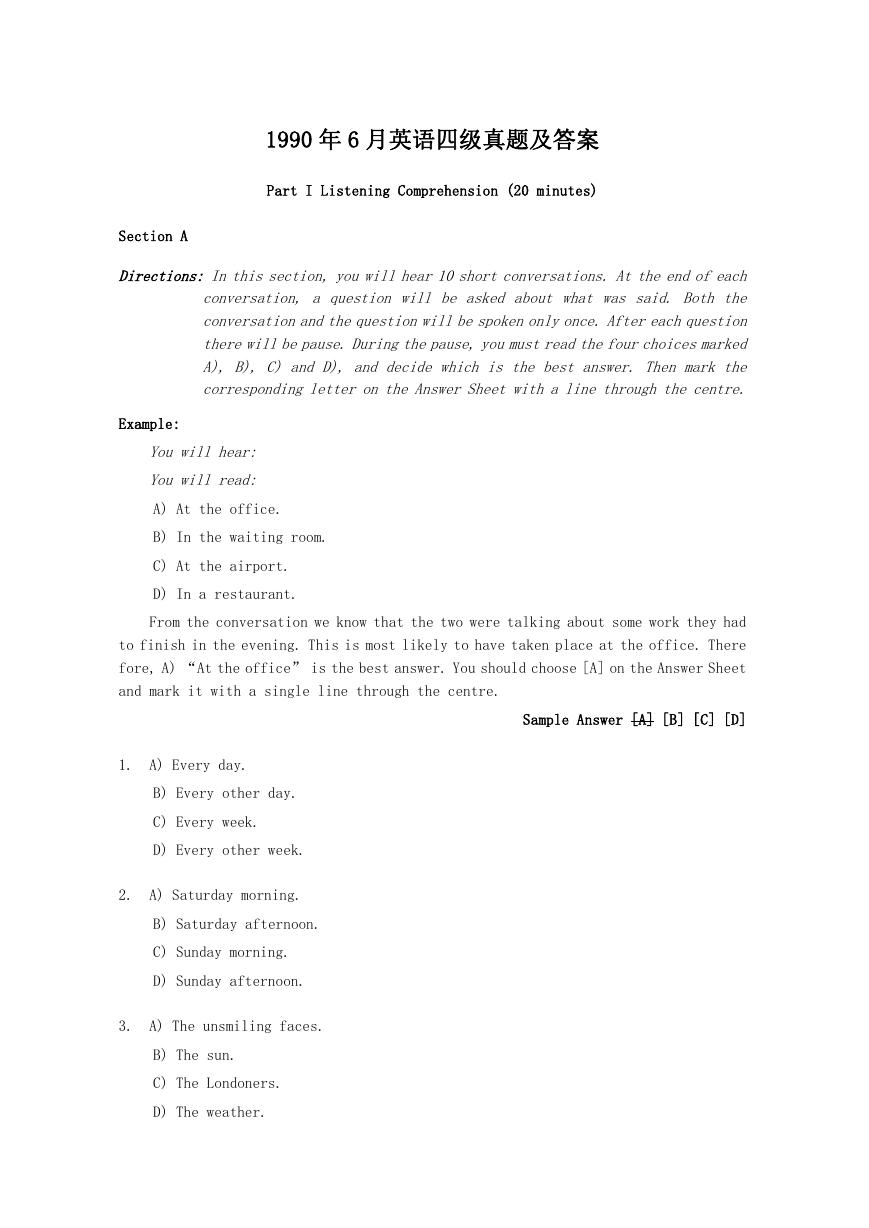
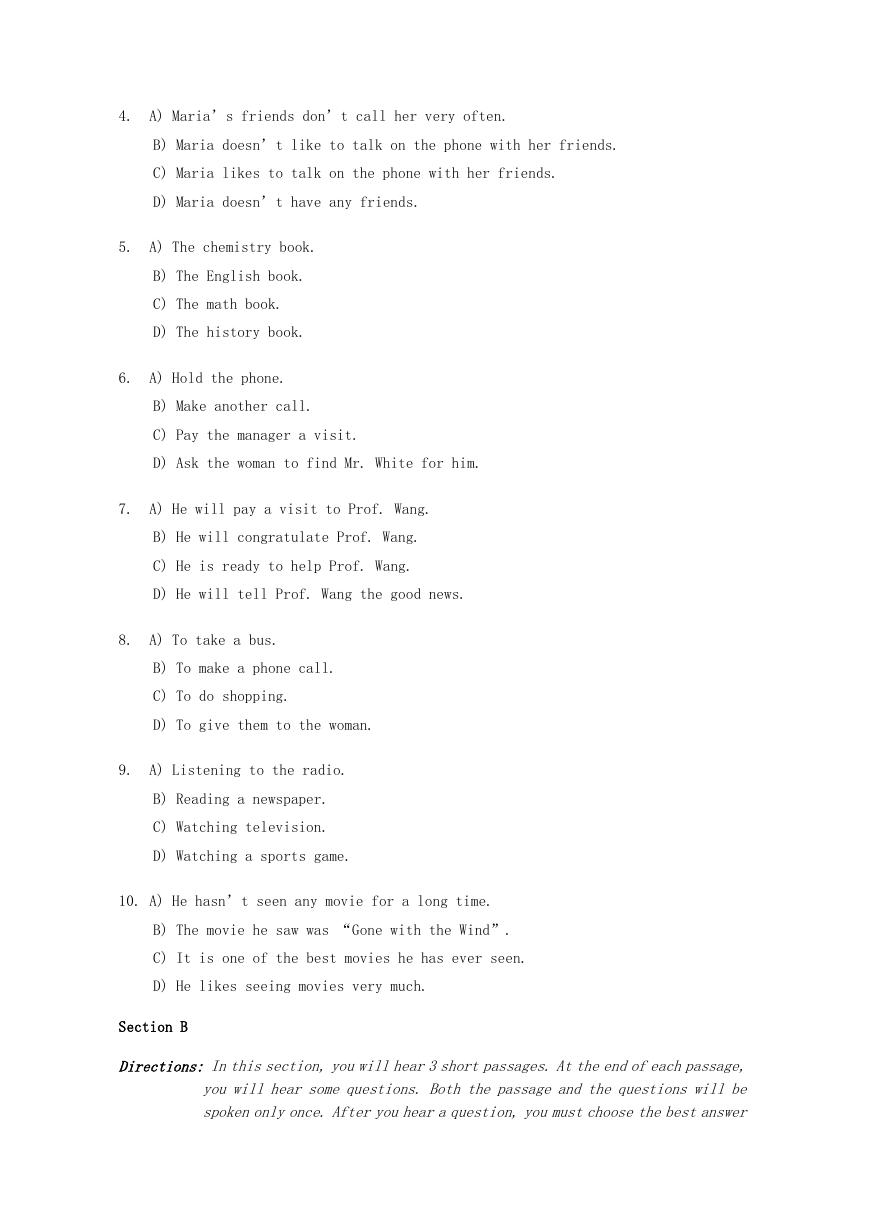

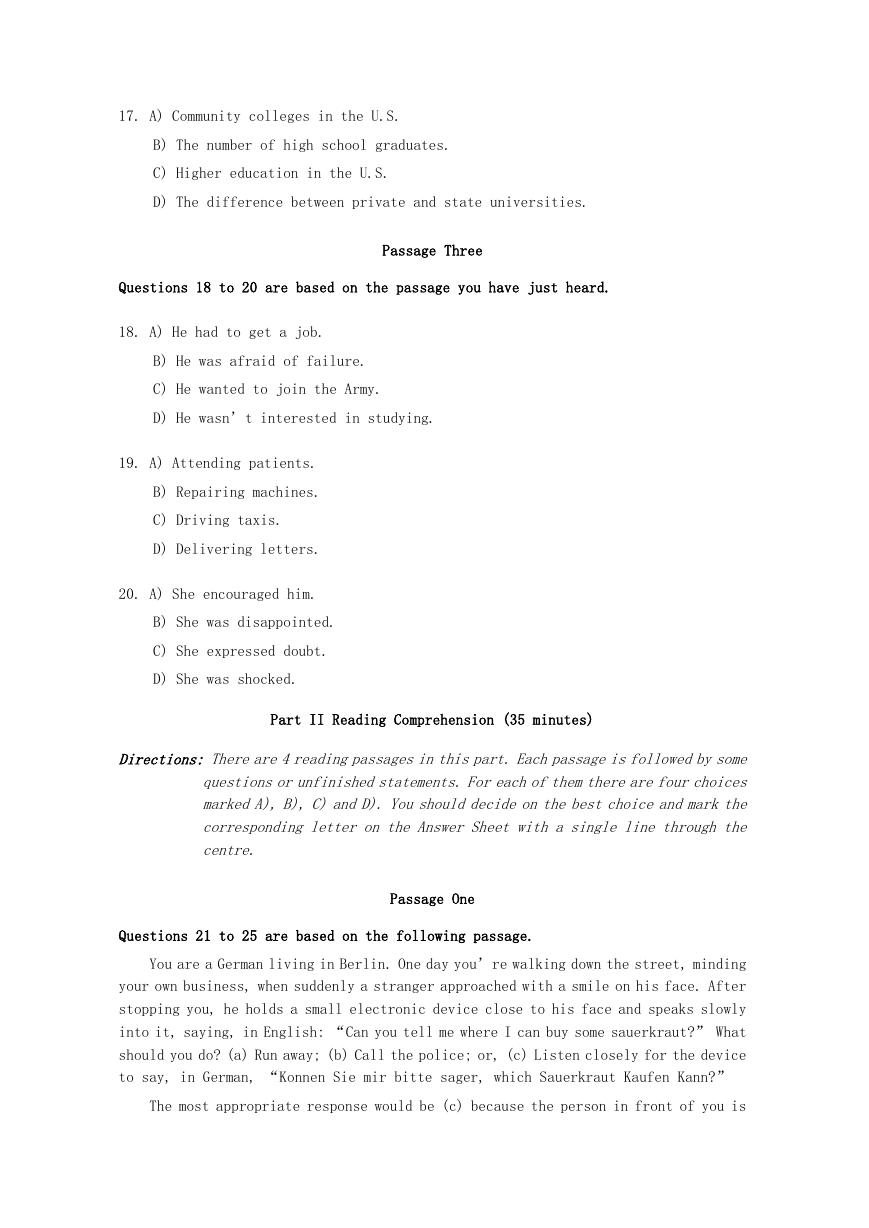
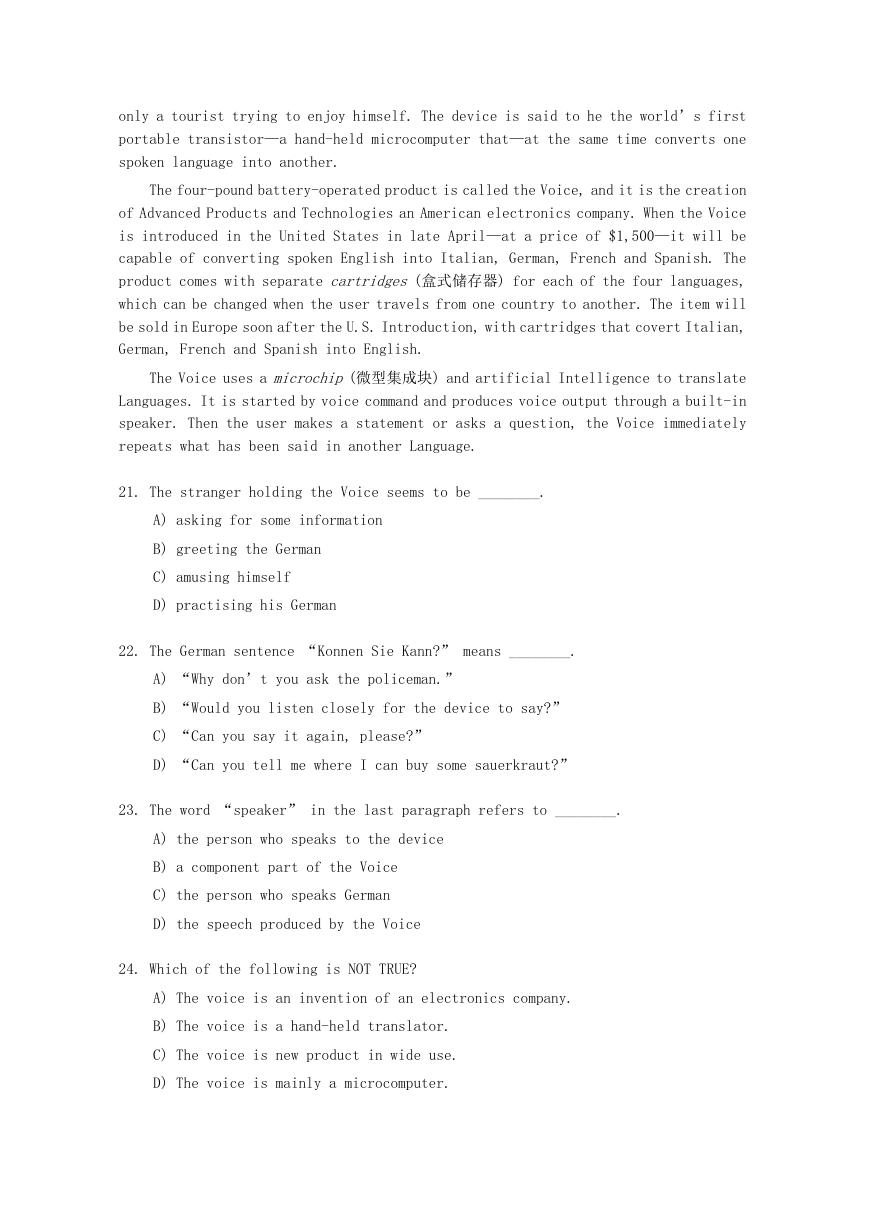


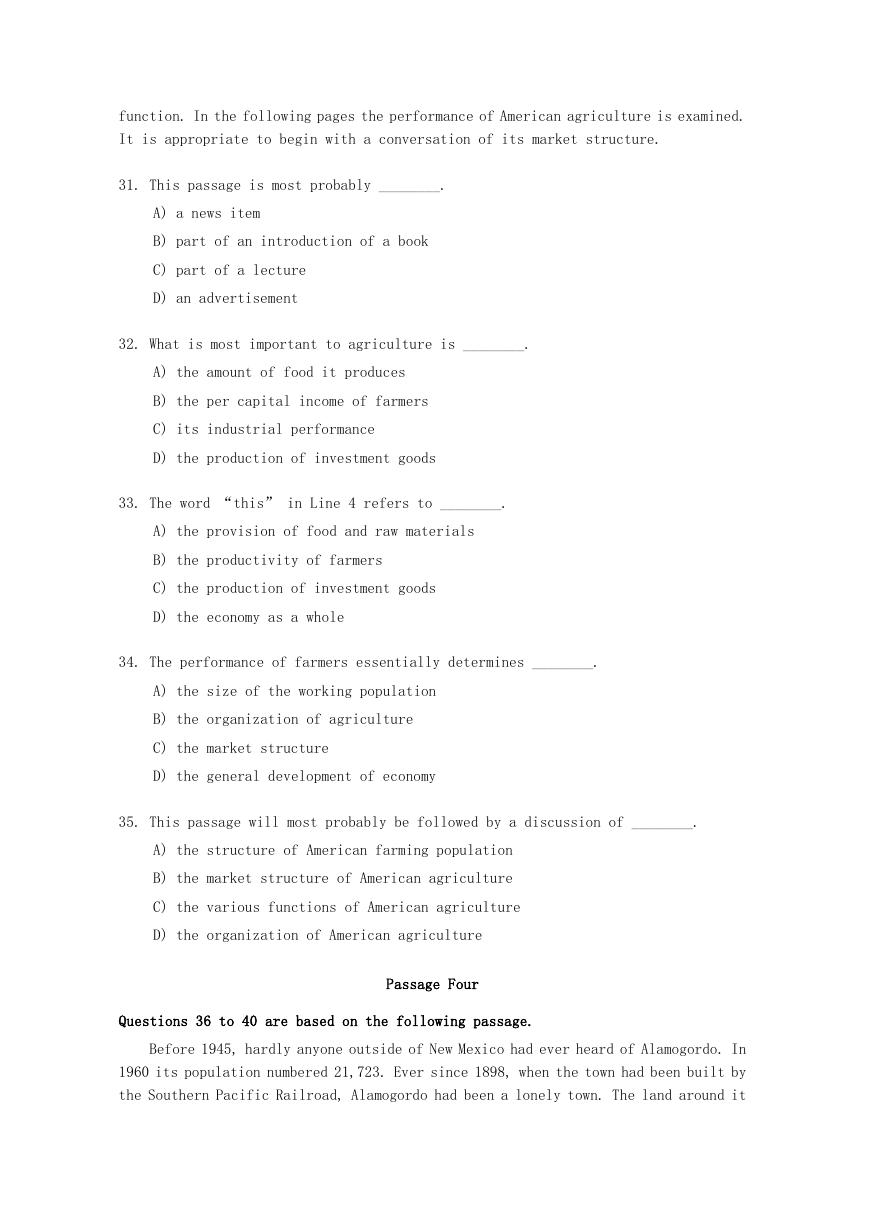








 2023年江西萍乡中考道德与法治真题及答案.doc
2023年江西萍乡中考道德与法治真题及答案.doc 2012年重庆南川中考生物真题及答案.doc
2012年重庆南川中考生物真题及答案.doc 2013年江西师范大学地理学综合及文艺理论基础考研真题.doc
2013年江西师范大学地理学综合及文艺理论基础考研真题.doc 2020年四川甘孜小升初语文真题及答案I卷.doc
2020年四川甘孜小升初语文真题及答案I卷.doc 2020年注册岩土工程师专业基础考试真题及答案.doc
2020年注册岩土工程师专业基础考试真题及答案.doc 2023-2024学年福建省厦门市九年级上学期数学月考试题及答案.doc
2023-2024学年福建省厦门市九年级上学期数学月考试题及答案.doc 2021-2022学年辽宁省沈阳市大东区九年级上学期语文期末试题及答案.doc
2021-2022学年辽宁省沈阳市大东区九年级上学期语文期末试题及答案.doc 2022-2023学年北京东城区初三第一学期物理期末试卷及答案.doc
2022-2023学年北京东城区初三第一学期物理期末试卷及答案.doc 2018上半年江西教师资格初中地理学科知识与教学能力真题及答案.doc
2018上半年江西教师资格初中地理学科知识与教学能力真题及答案.doc 2012年河北国家公务员申论考试真题及答案-省级.doc
2012年河北国家公务员申论考试真题及答案-省级.doc 2020-2021学年江苏省扬州市江都区邵樊片九年级上学期数学第一次质量检测试题及答案.doc
2020-2021学年江苏省扬州市江都区邵樊片九年级上学期数学第一次质量检测试题及答案.doc 2022下半年黑龙江教师资格证中学综合素质真题及答案.doc
2022下半年黑龙江教师资格证中学综合素质真题及答案.doc